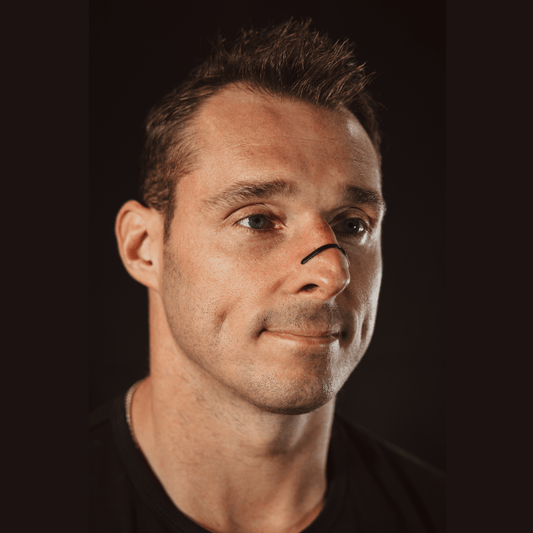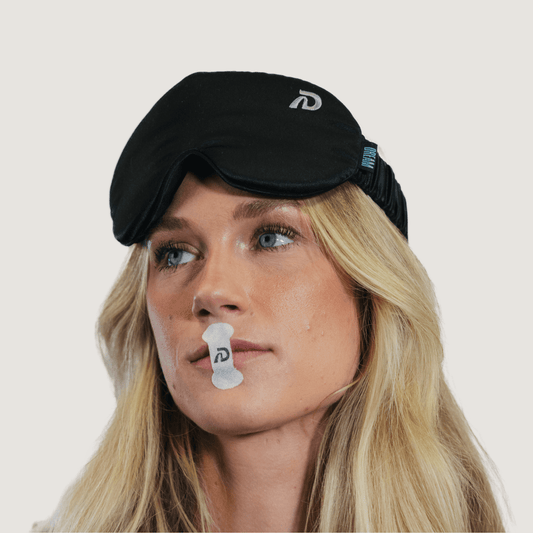Research Hub 🔬
DISCOVERING THE SCIENCE BEHIND OUR PRODUCTS 🧬
Welcome to the Research Hub, where we delve deep into the science behind our innovative products to bring you the very best in sleep and wellness solutions. Our dedicated team has spent years conducting research, collaborating with top professionals in the field, and rigorously testing each product to ensure they meet the highest standards of quality and effectiveness
Collapsible content
HRV
In the context of athletic health, nasal breathing plays a pivotal role in influencing heart rate variability (HRV), the measure of variations between heartbeats. Athletes and health-conscious individuals take note: a higher HRV is a marker of enhanced physical and mental health, and is often linked to improved performance across various domains. Engaging in slow nasal breathing exercises, like taking six breaths per minute, has been scientifically demonstrated to boost HRV. This improvement in HRV can unlock multiple benefits, ranging from elevating sports performance to providing relief from conditions like asthma and Irritable Bowel Syndrome (IBS). Incorporating such breathing techniques can be a strategic component in an athlete's health and performance regimen.
https://pubmed.ncbi.nlm.nih.gov/23029969/
https://pubmed.ncbi.nlm.nih.gov/29771730/
Performance & Endurance
Nasal breathing is a bit like a secret power-up for your endurance, especially when you're doing physical activities. You know how sometimes you feel like you can't go any further when exercising? That's often because your lungs are struggling to grab enough oxygen. But here's a cool fact: breathing through your nose can actually help your body use oxygen better – it's linked to a higher oxygen uptake (that's VO2 max in doctor-speak), and that's super important for keeping you going longer. It's all about getting the most out of the oxygen you breathe in during workouts. Also, there's this neat technique called intermittent hypoxic training, where you practice breathing in certain ways, like nasal breathing, to boost your body's ability to do aerobic activities and improve your overall endurance. It's like training your lungs to be more efficient athletes!
Relaxation
When you're feeling stressed out, nasal breathing exercises can be a real lifesaver for helping you chill out. Here's how it works: these exercises switch on your parasympathetic nervous system. Think of this as your body's natural relaxation mode. It gets going when you send signals through a super-important nerve called the vagus nerve. Whether you're doing it on purpose or just breathing normally through your nose, this kind of breathing can do some pretty cool things. It can slow down your heartbeat, make your breathing more relaxed, and even reduce cortisol levels – that's the stress hormone. All this adds up to helping you feel more calm and relaxed. So, next time you're feeling the pressure, remember: a few deep nasal breaths might just do the trick!
Jawline / Facial Aesthetics
Mouth breathing, often initiated during childhood, is associated with maladaptive jaw posture. Clinically, a 'mouth-breathing facial posture' is characterized by a notable lack of postural equilibrium. Conversely, nasal breathing has been observed to facilitate the correct alignment of the jawline. This corrective action by nasal breathing can result in more defined and balanced facial features. The impact of breathing patterns on craniofacial development underscores the importance of addressing mouth breathing early in life to promote optimal facial structure development.
https://www.mewing.app/blog/mouth-breathing-vs-nose-breathing
https://www.myofunctionaladvantage.com/mouth-breathing/
REM Sleep
Mouth taping during sleep has garnered attention in the medical community for its potential to enhance the quality of rapid eye movement (REM) sleep, a critical phase of the sleep cycle. REM sleep, known for its association with vivid dreaming, plays a significant role in cognitive functions such as memory consolidation and emotional processing. Mouth taping encourages nasal breathing, which can lead to a more regulated and efficient breathing pattern. This, in turn, may improve oxygenation and reduce sleep disturbances, such as snoring and mild forms of sleep apnea, which often disrupt REM sleep. By ensuring a steady, uninterrupted airflow through the nasal passages, mouth taping could potentially enhance the quality of REM sleep, thereby contributing to better overall sleep quality and, consequently, to improved cognitive and emotional well-being.
Cardiovascular Health
Nasal breathing is really important for keeping your heart and blood vessels healthy, and here's a cool reason why: it helps make Nitric Oxide. This isn't just any gas – it's a special kind that makes your blood vessels widen, which is great for blood flow. When you breathe through your nose, you release this Nitric Oxide, and it works like a charm to open up those vessels. Also, if you practice slow and steady breathing through your nose, it could have some awesome benefits for your heart health. It can help keep things like your blood pressure and heart rate in a good range. Think of it like a mini workout for your heart and blood vessels, just by breathing in a certain way!
https://onlinelibrary.wiley.com/doi/abs/10.1046/j.1365-201X.1996.557321000.x
Focus & ADHD
Nasal breathing exercises are not just for relaxation; they're also great for boosting your focus and attention. Here's the science behind it: studies have found that the way you breathe, especially when you breathe through your nose, can wake up parts of your brain that handle attention and being alert. One type of nasal breathing, where you breathe quickly through your nose, is especially good at this. It kicks your sympathetic nervous system into gear – that's the part of your nervous system that gets you ready for action. At the same time, it dials down the activity of the vagus nerve, which is more about relaxation. This combination can really help you stay sharp and concentrate better. So, next time you need to focus, some quick nasal breaths might just do the trick!
Anxiety
Nasal breathing exercises are like a gentle workout for your vagus nerve, which is like a big boss nerve that connects your brain to important body parts like your heart and lungs. This nerve is super important for keeping stress and emotions in check. When we sleep, we can't really control how we breathe, but if we use a little trick like mouth taping to breathe through our noses, it helps to turn on our body's chill-out system, known as the parasympathetic nervous system. This helps us feel calm and relaxed. Plus, breathing lightly through our nose can help us get used to more carbon dioxide in our bodies, which can be good for easing feelings of anxiety and panic. It does this by calming a part of the brain called the amygdala and helping our heartbeat and breathing to work together in a nice, steady rhythm.
https://www.sciencedirect.com/science/article/abs/pii/S0022395607001033?via%3Dihub
Sleep Apnea
Nasal blockages are closely linked to sleep apnea, a condition where you stop and start breathing while sleeping. Keeping up with nasal breathing exercises can be really helpful in clearing up your nose and making your breathing quieter and more gentle. This can actually ease sleep apnea symptoms and cut down on snoring. There was this study where they found that when people got better at breathing through their noses, a lot of them snored less. Plus, they felt more energetic during the day. So, if you're struggling with sleep apnea or snoring, focusing on nasal breathing might be a good idea to help you sleep better and feel more awake the next day!
Enhanced Mood & Energy Levels
Nasal breathing can really make a difference in how you feel, and it works through some neat body processes. Research tells us that when you breathe quickly through your nose, it can actually help you become more alert and focused. Here's why: this kind of breathing gets your sympathetic nervous system going – that's the part of your body that gears you up for action. At the same time, it tones down the activity of the vagus nerve, which usually helps you relax. So, what this means is nasal breathing can be a kind of booster for your energy and concentration. It's like flipping a switch in your body that helps you pay more attention and feel more awake!
Oxygen Flow
Nasal breathing and breathing the right way delivers oxygen and carbon dioxide to the cells and tissues of the body. Increased oxygen flow throughout the body means better recovery, performance and so much more.
https://hubermanlab.com/how-to-breathe-correctly-for-optimal-health-mood-learning-and-performance/
Reduced Snoring
Using Mouth tape such as Dream Tape, during sleep led to substantial reductions in key metrics associated with sleep-disordered breathing. The Apnea/Hypopnea Index (AHI), a measure of the severity of sleep apnea, showed a reduction of approximately 50%. Similarly, the Snoring Index (SI), a quantitative measure of snoring frequency, was also reduced by around 50%.
https://www.ncbi.nlm.nih.gov/pmc/articles/PMC9498537/
https://pubmed.ncbi.nlm.nih.gov/25450408/
Featured collection
-
NEW!

-
Most Popular
 SaleSale
SaleSale -




